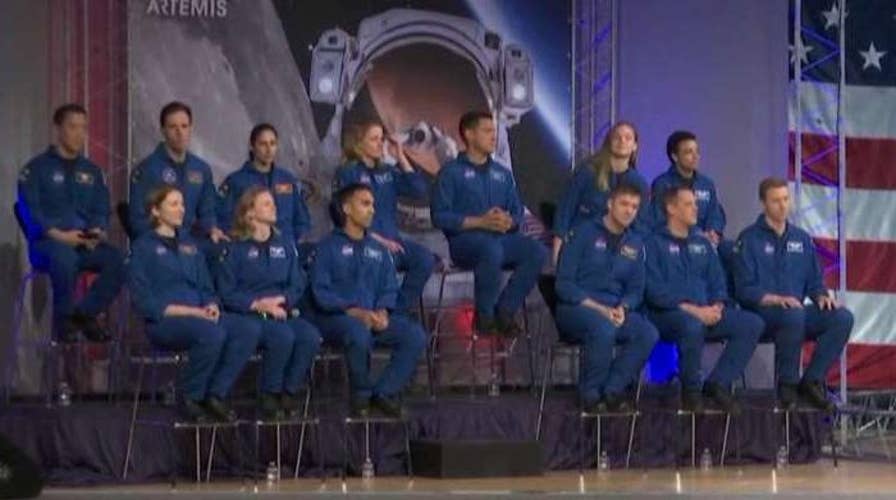Graduating class of NASA astronauts under Artemis could go to the Moon, Mars
NASA’s Artemis program encompasses the development of technologies that could send humans to the Moon and Mars; NASA administrator Jim Bridenstine joins ‘America’s News HQ.’
Are we going to Mars in 2020? Yes! A convoy of spacecraft will be heading to Mars this summer, when four robotic missions from around the globe will be launched to the Red Planet. Among those missions will be America’s 2020 Rover, with a scheduled launch date in July, which will be NASA’s most ambitious Mars mission to date.
The 2020 Rover will not be alone. Three other missions will also be heading to Mars this summer.
The European Space Agency (ESA), in partnership with the Russian space agency Roscomos, is scheduled to launch the ExoMars rover. This rover will not only be able to traverse the Martian surface, but it will also carry a drill designed to collect samples up to a depth of 2 meters below the surface to search for signs of life (past or present).
In addition, the United Arab Emirates (UAE) is also expected to join the select group of nations that have sent missions to Mars. To mark the 50th anniversary of their independence, the UAE will be launching their ‘Hope’ orbiter that will analyze the Martian atmosphere.
China also understands the scientific and technological importance of Mars exploration. Their Huoxing-1 mission will launch carrying an orbiter and rover. As with the 2020 Rover and ExoMars, one of the primary missions of the Chinese mission is to search for evidence of life.
CLICK HERE TO GET THE OPINION NEWSLETTER
Indeed, the Mars 2020 rover, which is based on the same design as the Curiosity rover of 2012, will carry a remarkable payload of instruments that could not only help to enable us to send humans to Mars in the 2030s but could also determine whether life has ever existed on the Red Planet:
- MOXIE (Mars OXygen In situ resource utilization Experiment): MOXIE will be the first in-situ resource utilization (ISRU) experiment ever sent to Mars. It is designed to demonstrate a method for extracting oxygen from the carbon dioxide in the atmosphere. This oxygen could be used not only for propellant on future missions but also for the crew to breathe. MOXIE is an important step to help determine whether humanity will be able to utilize local resources to “live off the land” on the planet.
- Mars helicopter: A small helicopter will be carried on the 2020 Rover. If this small vehicle succeeds, it will be the first aircraft to fly on Mars or on any planet other than Earth. Helicopters/drones may be able to explore locations that are otherwise inaccessible – such as cliff sides – and cover far more territory than rovers and at a resolution that cannot be achieved by current orbital assets. This capability could one day explore terrain and identify science targets in advance of human crews.
- Sample return: The 2020 Rover will also collect and cache samples of soil deposits (also known as regolith) that will be retrieved during a later mission for a return to Earth. The regolith collected by the 2020 Rover will be the first samples ever brought back to our home planet for analysis. These samples will not only help assess whether there was ever life on Mars, but will also inform our understanding of how to design human habitats, suits, and rovers for the Martian environment and of potential human health hazards (such as breathing hazards) in the regolith. It will also be the first demonstration of a round-trip mission to and from Mars.
- Search for past life: The 2020 Rover will also investigate whether Mars was ever habitable in the past and it will search for signs that the planet sustained microbial life at one time.
Never before has there been such an extensive suite of international investigations of Mars or any other destination in space.
More from Opinion
As the United States accelerates its plans to return to the Moon and then to send humans to Mars, this 2020 Mars caravan could not be more perfectly timed. These missions will generate numerous secondary benefits, including:
- Building public excitement: When the Curiosity rover landed, it generated an enormous amount of public excitement and interest in Mars exploration. That excitement could be eclipsed by the historic missions being launched in 2020.
- Keeping mission planners focused on Mars: As the United States and its partners plan for a return to the Moon by the mid-2020s, they must design those plans in a manner that does not hinder, but rather advances, the goal of sending humans to Mars.
- Helping to clarify ‘why’ we are sending humans to Mars.
- Clearly demonstrating that the entire world sees the importance of Mars exploration.
CLICK HERE TO GET THE FOX NEWS APP
Each of these missions to be launched in 2020 is scheduled to arrive at Mars in early 2021. If these missions are successful, they could very well help us to understand the nature of life in the universe and help assure that human life will be on the surface of Mars within the next 15 years.
Rick Zucker is Vice President, Policy of Explore Mars, Inc.










































